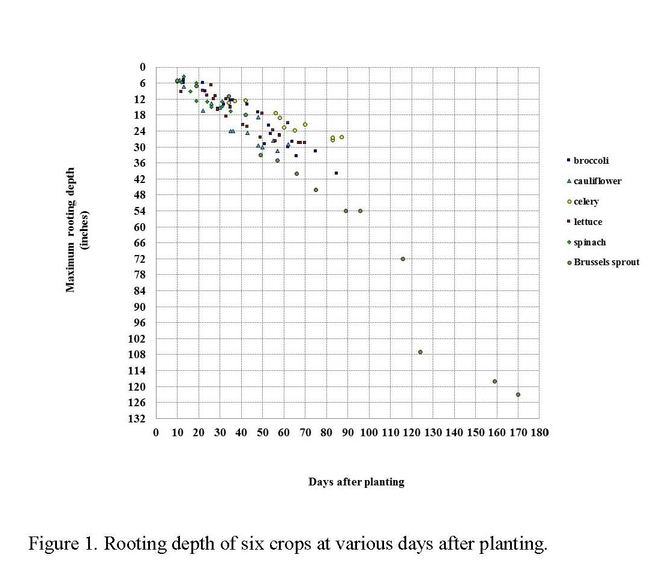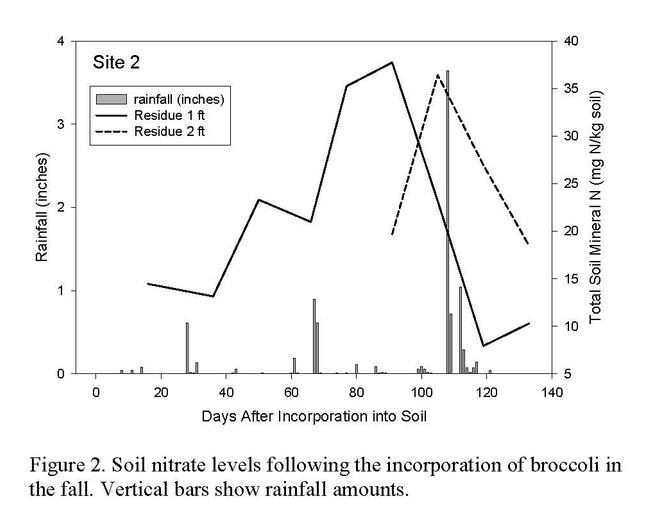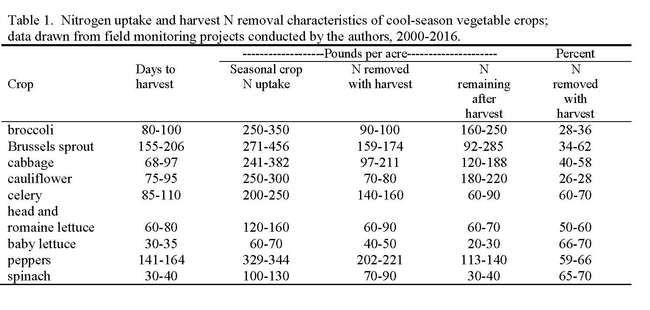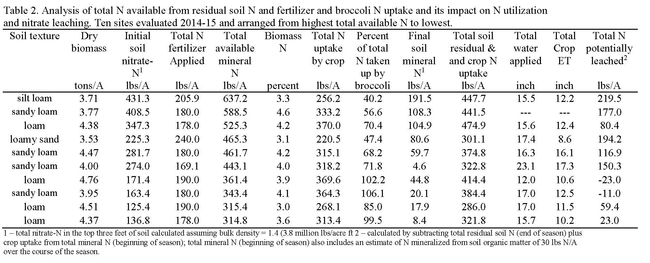Efficient management of nitrogen (N) in the cool season vegetable production areas of the Central Coast has a number of challenges. Many of the vegetable crops, such as leafy greens, are shallow rooted, fast maturing with a high N-demand, and produced in multiple rotations per year. The high N demand by these crops is often during the last half of the crop cycle. For instance, lettuce takes up about 70% of the total N requirement during the last 30 days of a 60-65 day crop cycle, and spinach takes up a similar percentage in the last 15 days of a 30 day crop cycle. These vegetables also have strict quality standards for size, weight and deep green color of the product which can result in greater use of N fertilizer. Crop residues incorporated after harvest can contribute significant amounts of N back into the soil, and increase the risk of nitrate leaching losses during the establishment irrigations of a subsequent crop, or during significant rain events. High land rents restrict the ability of producers to effectively rotate to cover crops that could take up excess residual soil nitrate from the soil.
In response to these challenges, growers are implementing practices such as monitoring residual soil nitrate levels and accounting for them in fertilizer decisions, and have become more careful in managing irrigations to minimize nitrate leaching losses. Less attention has been paid to the impact of rotations on nitrogen use efficiency (NUE). Deep rooted cover crops and vegetable crops grown in rotation with shallow rooted vegetables can sequester nitrate. Careful management of nitrogen inputs and use of rotational crops can provide a means of maintaining N in the rooting zone of the crops, reducing losses to groundwater and improving NUE.
Rotational crops function by capturing residual N in the soil and incorporating it into their crop tissue. By capturing N in the soil profile that might otherwise be lost by leaching beyond the rootzone they mitigate losses of N from prior rotations.
Background on Nitrogen Management
Nitrate (NO3-) is a negatively charged molecule and does not adhere to the negative charges on clay or organic matter. Rather, nitrate resides in the water held in soil pores and can be easily carried downward following an irrigation or rain event. This fact underscores the need for careful irrigation management to effectively manage N in vegetable production systems.
After a winter of normal to high rainfall, soil nitrate levels are typically low at the beginning of the crop cycle in the spring due to leaching during winter fallow. However, as the season progresses, soil nitrate levels build up from unused fertilizer, mineralization of soil organic matter (including prior crop residues) and nitrate from irrigation water. The amount of nitrogen in vegetable crop residues following harvest ranges from 20 to >250 lbs N/acre (Table 1). Nitrogen mineralization from crop residues is initially rapid, with faster mineralization occurring in residues with higher N content. For instance in a trial that we conducted, residue containing 5% N mineralized 63% of its N content in 4 weeks, compared to 43% for residue containing 3.8% N. Following the rapid breakdown phase, crop residues break down at a slower rate that can last over a period of months or longer.
Mineral nitrogen is also released from decomposition of soil organic matter and the quantity made available depends on the percent organic matter in the soil. Soil organic matter contains about 5-6% N. In the summer when soil temperatures are above 70 °F, the quantity of N mineralized typically ranges from 0.5 to 1.5 lbs N/acre/day. During the winter when soil temperatures range between 50 and 60 °F, mineralization from soil organic matter slows, but does not entirely stop.
Nitrate in irrigation water is another source of N. Many irrigation wells in the Salinas Valley contain nitrate-N in the range of 10-30 ppm NO3-N (representing 2.3-6.9 lb N/acre inch of water) and some wells may contain as much as 60-70 ppm NO3-N (13.8-16.1 lbs N/acre inch of water). Several years of field trials have demonstrated that the N in irrigation water contributes to crop growth similar to fertilizer N.
Growers are under increasing regulation to improve NUE. Strategies to improve NUE include moving away from program based fertilizer programs to field by field decision based strategies that utilize measurements of residual soil nitrate. Soil nitrate measurements can be made several ways, but the nitrate quick test provides a reliable method to quickly assess levels of residual soil nitrate in the soil prior to a fertilization event //ucanr.edu/blogs/blogcore/postdetail.cfm?postnum=4406. If testing indicates that sufficient residual soil nitrate is present, it is possible to reduce or skip a fertilizer application. In this way, it is possible to take full advantage of residual soil nitrate, reduce the quantity of fertilizer applied to the crop and maintain optimal yields (For a more detailed explanation go to: http://cemonterey.ucanr.edu/files/259776.pdf ).
In spite of best efforts at efficiently managing N in agricultural systems, inefficiencies occur, and some nitrate can leach beyond the crop root zone. Rotating with a crop that takes up and utilizes excess nitrate from the soil would help increase NUE. Winter cover crops can capture a significant portion of excess residual nitrogen during the winter fallow period. Studies in the Salinas Valley showed that cover crops reduced nitrate leaching by 65-75% (Wyland et al 1996; Heinrich et al 2014). Cover crops can accumulate 100-200 lbs N/acre and the residue begins to mineralize N upon incorporation into the soil in the spring. Unfortunately, the use of cover crops in the Salinas Valley is limited by their impact on planting schedules, and as a result, probably no more than 5% of the vegetable acreage is cover cropped each year.
N Scavenging by deep rooted vegetable crops
Ten trials were conducted from 2014-15 evaluating the impact of broccoli grown after a prior crop of lettuce on nitrate leaching. Quantities of residual soil nitrate in the top three feet of soil at the beginning of the broccoli crop cycle ranged from 134 to 431 lbs N/acre (Table 2). The quantity of fertilizer N applied to broccoli crop ranged from 169 to 240 lbs N/acre, while the crop took up 220 to 370 lbs N/acre in the above ground biomass. In 9 out of the 10 sites, broccoli took up more N than was applied as fertilizer, and effectively scavenged residual soil nitrate from the soil. By maturity, broccoli took up 40 to 106% of applied fertilizer N and initial residual soil nitrate-N in the top 3 feet of soil. In calculating the N budget for the crop cycle, we estimated that nitrate leaching losses ranged from 0 to 219 lbs N/acre.
The main indicator of whether broccoli could reduce the risk of nitrate leaching was the level of soil nitrate at the beginning of the crop cycle. When initial soil nitrate levels in the top three feet of soil were <200 lbs N/acre, broccoli was more effective at reducing the risk of nitrate leaching. This emphasizes the need to finish the prior lettuce crop with low to moderate amounts of residual soil nitrate. This can be achieved by utilizing the best management practices described above.
Broccoli roots extend down to 40 inches by the end of the crop cycle (Figure 1). Sufficient root density occurs in the second foot of soil by 50 days after planting such that the crop can effectively utilize nitrate at that depth in the soil profile. Broccoli often uses up most of the N in the top foot of soil after mid-cycle and relies on N in the second foot to reach maturity.
The above-ground biomass of dry broccoli contained from 3.0 to 4.6% N. The high concentration of N in broccoli biomass in conjunction with relatively high dry matter content (4.0 tons dry matter/acre) results in the large amount of N in the biomass.
Broccoli is not the only crop with the ability to scavenge residual soil nitrate; nitrate scavenging has also been observed in Brussels sprouts, cabbage, cauliflower, carrots, celery, peppers and processing tomatoes. What these crops have in common is a relatively long production season that allows roots to grow to a substantial depth, and modest seasonal N fertilization rates compared to their N uptake capacity. Faster, more shallowly-rooted crops (i.e. spinach and other baby greens) have limited scavenging ability, and in fact usually receive substantially more fertilizer N than they take up.
Planting deep rooted cash crops can serve as a best management practice in intensive vegetable cropping systems because their roots can intercept nitrate that would otherwise be lost to leaching, and put it to productive use for crop production. In order to be successful, the scavenged N contained in the crop must be removed from the site in the harvested product or successfully cycled to the next crop. Lower amounts of N leave the field in the harvested product of broccoli and cauliflower than other scavenging crops such as cabbage and peppers (Table 1). The amount of N in crop residue after harvest can be substantial in cole crops. If a cole crop is incorporated into the soil prior to a subsequent crop such as lettuce, the N mineralized from the crop residue can be taken up by the lettuce with careful crop management. If the broccoli crop is incorporated into the soil prior to the winter fallow, the N mineralized from the crop residue can be lost by leaching in winter rains (Figure 2).
In summary, these studies showed that broccoli and other deep rooted vegetable crops can take up more N than is routinely applied to them. Broccoli can take up nitrate deeper in the soil profile than other crops such as spinach and lettuce, which are more shallowly rooted. The scavenged N is put to productive use and kept from immediately loss through leaching. If used effectively, scavenging of N by deep rooted crops can improve NUE and delay and reduce N leaching in cool season vegetable production systems.



